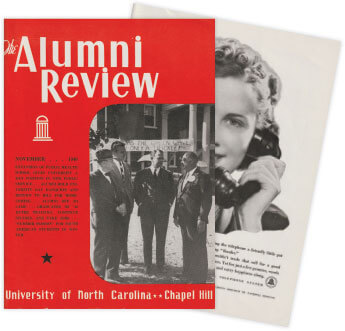Dr. Amir Barzin and Amy Loftis explain the testing process by the PCR testing machine at UNC-CH COVID Surveillance Laboratory.
More than a century after the first global flu pandemic brought the importance of public health center stage, the year 2020 marked the School’s 80th anniversary — a milestone occurring in the midst of another global pandemic that again put public health in the spotlight.
Some of the societal ills that led to the creation of UNC’s public health school in 1940, such as poverty and inequity, still persist, and the pandemic and social justice protests we saw in 2020 have only amplified the need to make systemic changes.
UNC-Chapel Hill trustees officially established the School of Public Health in 1940 – but the road to a separate public health school began much earlier. In the early 20th century, North Carolina faced a health crisis: Illnesses like hookworm and tuberculosis and other illnesses were rampant, and many North Carolinians were poor and undernourished, making them even more vulnerable to disease.
To address these health challenges, UNC medical school faculty members and public health professionals began building partnerships in communities across the state to improve treatment and prevention of disease. Backed largely by support from private foundations, those efforts made it clear that N.C. needed a state-based training program for public health workers. In 1936, the widely renowned former Harvard Professor Milton Rosenau, MD, agreed to lead the division of public health within UNC’s medical school.
“Our goal has always been to make a real difference for all people. And there’s still so much work to do.”

A person approaches a COVID-19 testing location on the campus of the UNC-Chapel Hill.
Our mission – to improve public health, promote individual well-being and eliminate health inequities across N.C. and around the world – hinges on our shared commitment to excellence and our collaborative approach to teaching, research and service. Over the School’s eight decades, we’ve grown and changed, but those values remain a north star that guides our work.
At Gillings, we live our mission in many ways every day. In every department, students and faculty go beyond the classroom, working together in scientific labs and clinical settings, and with community and global organizations, to help solve real-world problems. Gillings researchers contribute knowledge and discoveries that influence public policy and transform public health practices. We continue to build and nurture treasured and purposeful partnerships that increase our global impact.
We’ve also honed our ability to pivot. In the 1940s, as the field of public health grew and as World War II broke out, the School adapted to meet the demand for training and consultation on pressing public health issues. From the outset, the School’s training programs and field work included a focus on racial equity. And throughout the 60s and 70s, as the civil rights movement took hold, we intensified our emphasis on the health of marginalized and underserved populations, and students and faculty organized and advocated for change. Even as the COVID-19 pandemic forced an adaptation to remote-based instruction and research, we collaborate – though often from a distance – to advance public health.
Through its eight decades, under the leadership of seven deans, and being home to thousands of faculty and students, the Gillings School has worked across all our disciplines to bridge the gap between academic research and the practice of public health. Our goal is – as it has always been – to make a positive impact for all people, in North Carolina and across the world. And there’s still so much work to do.
At 80, we’re Gillings. And we’re still on it.

Then and now ... Carolina Alumni Review from November 1940 trumpeting the opening of the school of public health. We opened with an enrollment of 63 master’s candidates and in 2021, we received 1,445 residential Master of Public Health applications.




.jpg)
